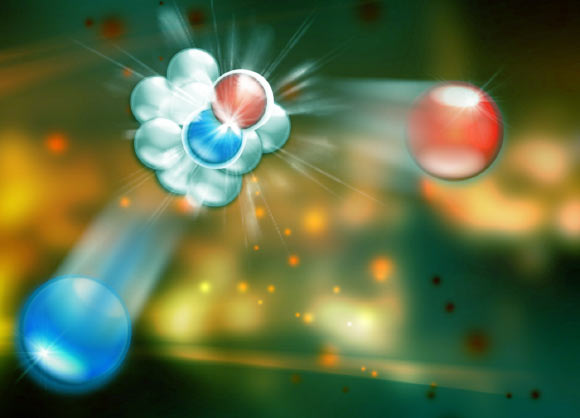Though widely thought to be a fluke when seen in earlier measurements, the new, more precise measurement has confirmed the presence of the anomaly and raises questions about its origin.

Proton is a subatomic particle found in the nucleus of every atom. This artist’s impression shows a proton and a neutron. Image credit: Joanna Griffin / Jefferson Lab / Penn State.
The measurements of the proton’s electric polarizability reveal how susceptible the proton is to deformation in an electric field.
Like size or charge, the electric polarizability is a fundamental property of proton structure.
What’s more, a precision determination of the proton’s electric polarizability can help bridge the different descriptions of the proton.
Depending on how it is probed, a proton may appear as an opaque single particle or as a composite particle made of three quarks held together by the strong force.
“We want to understand the substructure of the proton. And we can imagine it like a model with the three balanced quarks in the middle,” said Ruonan Li, a graduate student at Temple University.
“Now, put the proton in the electric field. The quarks have positive or negative charges. They will move in opposite directions. So, the electric polarizability reflects how easily the proton will be distorted by the electric field.”
To probe this distortion, nuclear physicists used a process called virtual Compton scattering.
In virtual Compton scattering, electrons interact with other particles by emitting an energetic photon, or particle of light.
The energy of the electron determines the energy of the photon it emits, which also determines how the photon interacts with other particles.
Lower energy photons may bounce off the surface of the proton, while more energetic photons will blast inside the proton to interact with one of its quarks.
Theory predicts that when these photon-quark interactions are plotted at from lower to higher energies, they will form a smooth curve.
“This simple picture didn’t hold up to scrutiny. The measurements instead revealed an as-yet-unexplained bump,” said Dr. Nikos Sparveris, a researcher at Temple University.
“What we see is that there is some local enhancement to the magnitude of the polarizability.”
“The polarizability decreases as the energy increases as expected. And, at some point, it appears to be coming temporarily up again before it will go down.”
“Based on our current theoretical understanding, it should follow a very simple behavior. We see something that deviates from this simple behavior. And this is the fact that is puzzling us at the moment.”
The theory predicts that the more energetic electrons are more directly probing the strong force as it binds the quarks together to make the proton.
This weird spike in the stiffness that nuclear physicists have now confirmed in the proton’s quarks signals that an unknown facet of the strong force may be at work.
“There is something that we’re clearly missing at this point,” Dr. Sparveris said.
“The proton is the only composite building block in nature that is stable. So, if we are missing something fundamental there, it has implications or consequences for all of physics.”
The team’s paper will appear today in the journal Nature.







